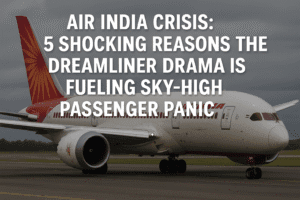Air India Crisis: 5 Shocking Reasons the Dreamliner Drama Is Fueling Sky-High Passenger Panic
Air India faces compounded operational crises following two precautionary flight diversions on June 16 – a Hong Kong-Delhi Dreamliner returning with a technical fault and a Delhi-Ranchi flight diverting mid-air. These incidents occur amid intense scrutiny after the June 12 Ahmedabad Dreamliner crash that killed 270 people. The Directorate General of Civil Aviation (DGCA) has mandated urgent fleet-wide inspections of all Air India 787 aircraft. Simultaneously, the closure of Iranian airspace due to Middle East tensions has forced major reroutes for transcontinental flights, causing significant delays.
Heavy Mumbai monsoon rains further disrupt domestic operations. This convergence of technical, geopolitical, and weather challenges strains resources and amplifies passenger anxiety while the airline navigates investigations and grief. Air India’s immediate priority remains demonstrating rigorous safety protocols through proactive measures like the recent diversions. Successfully managing this multi-faceted storm is critical for rebuilding passenger confidence during aviation’s most turbulent period in recent memory.

The skies are proving turbulent for Air India, not just meteorologically, but operationally and geopolitically. Two more flights joined a growing list of disruptions this week, amplifying concerns just days after the devastating Ahmedabad crash that claimed 270 lives.
The Immediate Incidents: Precaution Over Convenience
On Monday, June 16th, Air India faced two significant diversions:
- AI 315 (Hong Kong to Delhi): A Boeing 787-8 Dreamliner – the same model involved in the June 12th Ahmedabad tragedy (AI 171) – turned back to Hong Kong approximately 90 minutes after takeoff. Pilots initiated the return after detecting an unspecified technical fault, prioritizing safety despite the significant operational disruption.
- AI 9695 (Delhi to Ranchi): Shortly after takeoff, this domestic flight experienced a mid-air technical issue. Demonstrating heightened caution, the crew made the prudent decision to return to Delhi purely as a “safety precaution,” according to reports, foregoing the scheduled landing in Ranchi.
A Context of Intense Scrutiny and Grief
These incidents occur under a shadow:
- The Ahmedabad Aftermath: The catastrophic loss of flight AI 171, which included former Gujarat Chief Minister Vijay Rupani among the 270 victims, remains raw. Investigations are ongoing, and the nation is mourning.
- Regulatory Response: The Directorate General of Civil Aviation (DGCA) has mandated stringent, fleet-wide safety inspections for Air India’s Boeing 787-8 and 787-9 Dreamliners. This proactive measure, while not directly linking the diversions to the crash, reflects heightened vigilance. We’ve already seen impacts, like the delayed Delhi-Zurich flight on June 15th for mandatory checks.
- Recent Precedent: Just days before the diversions, flight AI 379 from Phuket to Delhi safely returned due to a bomb threat, further straining operations and passenger nerves.
The Broader Storm: Geopolitics and Weather Compound Challenges
Air India’s struggles extend beyond immediate technical concerns:
- Geopolitical Turbulence: Israeli airstrikes on Iran triggered the sudden closure of Iranian airspace starting June 13th. This critical corridor for India-Europe/North America flights forced major rerouting. Air India confirmed flights to destinations like New York, London, Toronto, and Frankfurt are taking significantly longer alternative paths via hubs like Vienna, Jeddah, or Sharjah, or even returning mid-journey. Passengers face extended travel times and uncertainty, advised to constantly monitor flight statuses.
- Monsoon Misery: Heavy rains and waterlogging in Mumbai have severely disrupted operations at Chhatrapati Shivaji Maharaj International Airport. Air India proactively warned passengers of potential delays and cancellations, adding another layer of frustration for travellers already contending with a complex web of disruptions.
The Human and Operational Toll: Restoring Confidence
This convergence of crises presents a monumental challenge for Air India:
- Passenger Anxiety: Repeated incidents, especially involving the Dreamliner fleet so soon after a major crash, inevitably fuel passenger apprehension. Clear, consistent communication and demonstrable safety actions are paramount.
- Operational Strain: Fleet inspections, unplanned diversions, geopolitical rerouting, and weather delays create a logistical nightmare, stretching resources, crew schedules, and ground operations thin.
- Rebuilding Trust: Beyond immediate operations, Air India faces the profound task of rebuilding public and regulatory trust in the wake of the Ahmedabad tragedy. Every precautionary landing, while necessary, is scrutinized; every delay adds to passenger frustration.
The Path Forward: Vigilance and Transparency
While the Dreamliner inspections are a necessary and visible response, the current situation underscores the immense pressures on global aviation:
- Safety First: The Hong Kong and Ranchi diversions demonstrate crews are erring heavily on the side of caution – a vital principle, even when inconvenient.
- Complex Interdependencies: Airlines operate within a fragile ecosystem. A conflict thousands of miles away (Iran) or intense local weather can cascade into widespread disruption.
- The Long Haul: Resolving Air India’s current challenges requires meticulous attention to maintenance, robust contingency planning for external shocks like geopolitics and weather, and, most crucially, transparent communication to reassure a justifiably concerned public navigating a difficult time.
The coming weeks will be critical. Air India’s ability to manage this “perfect storm” of technical vigilance, geopolitical instability, seasonal weather, and profound grief will define its path towards recovery and restoring confidence in its operations. For passengers, patience, coupled with vigilance about flight status, remains essential. The skies demand respect, and navigating them safely requires resilience from both airlines and those who fly with them.
You must be logged in to post a comment.